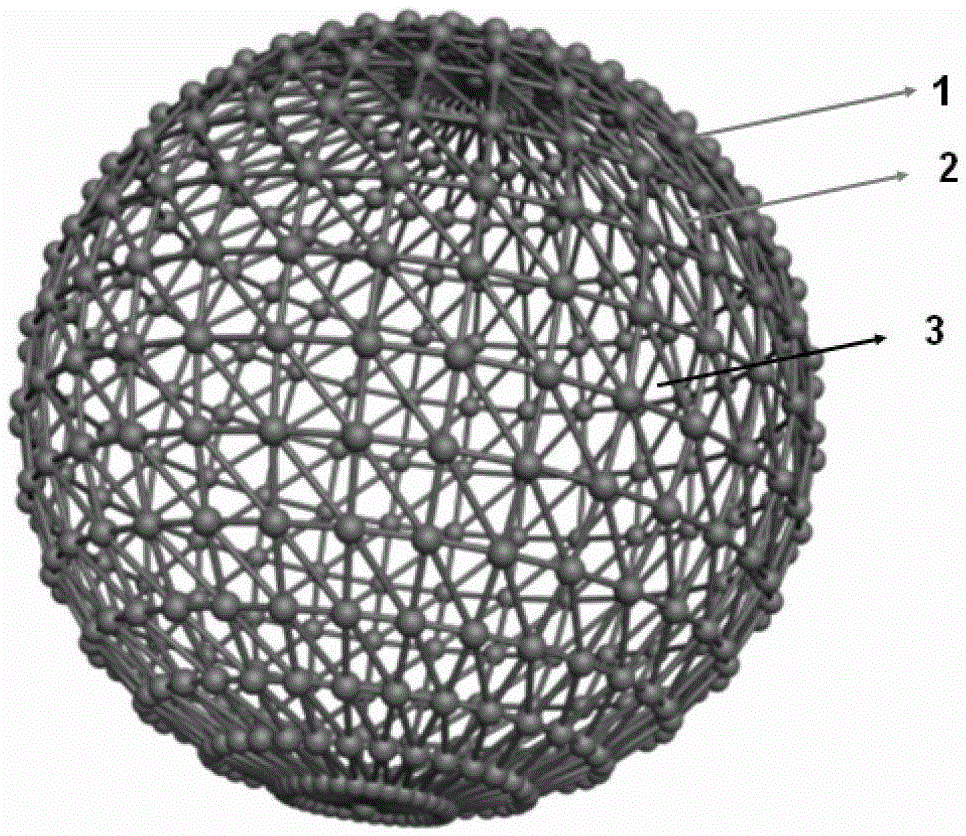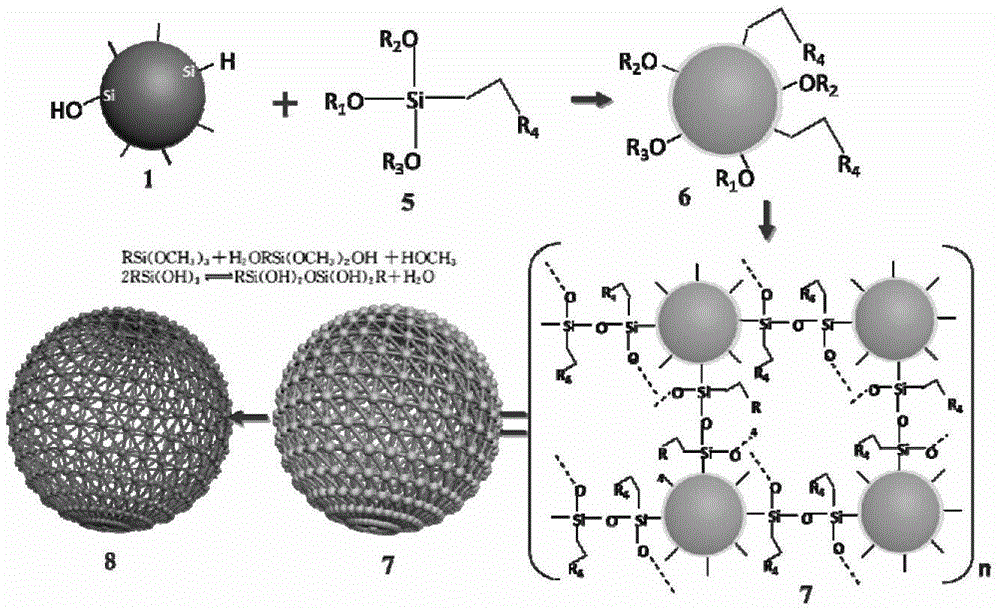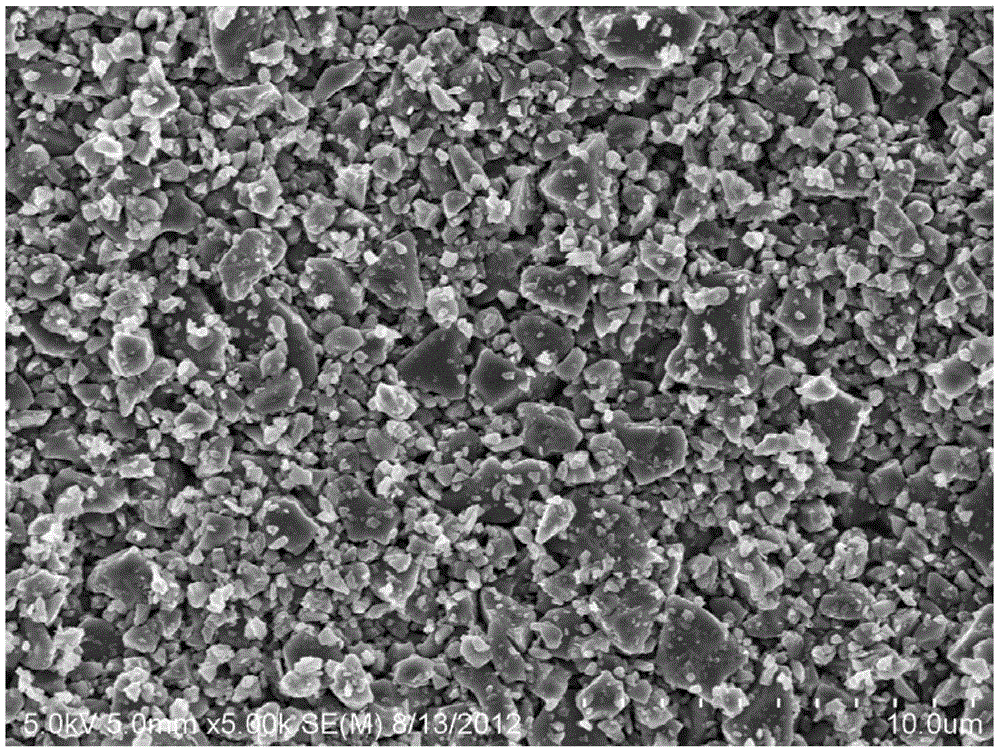A kind of silicon-based composite negative electrode material for lithium ion battery
A lithium-ion battery and negative electrode material technology, applied in battery electrodes, secondary batteries, circuits, etc., can solve the problems of nano-silicon material agglomeration, volume change and fragmentation, and achieve good electrochemical stability and stable material structure.
- Summary
- Abstract
- Description
- Claims
- Application Information
AI Technical Summary
Problems solved by technology
Method used
Image
Examples
Embodiment 1
[0039] Get 0.84g of silicon nanoparticles (particle diameter D50 is 30nm) and disperse in 8g of liquid vinyl tris (2-methoxyethoxy) silane monomer compound and stir for 6h. Add 1 mL of deionized water with a pH of 6.8, and keep stirring for 24 hours, add 12.32 g of ethanol solution of phenolic resin with a mass fraction of 50%, and continue stirring for 48 hours. While stirring, heat to 80 ° C for 48 hours to remove the solvent. The mixed solution solidifies.
[0040] The obtained cured precursor was treated at 750°C for 1h in a protective atmosphere, and then calcined at 1050°C for 1.5h to obtain a theoretical stoichiometric ratio of 1.86Si-SiO 1.5 C 8.7 Si-based composite bulk material.
[0041] The obtained silicon-oxygen-carbon composite material was magnetically crushed for 1 min, and processed under a planetary ball mill at 500 rpm for 12 h to obtain a negative electrode material for a lithium-ion battery with a particle size D90 of less than 30 μm. The scanning electr...
Embodiment 2
[0044] Get 1.78g of silicon nanoparticles (particle diameter D50 is 30nm) and disperse in 8g of liquid vinyl tris (2-methoxyethoxy) silane monomer compound and stir for 12h. Add 2 mL of deionized water with a pH of 6.8, and keep stirring for 48 hours, add 12.32 g of phenolic resin ethanol solution with a mass fraction of 50%, and continue stirring for 48 hours. Under the condition of stirring, heat to 80°C for 48 hours to remove the solvent. The mixed solution solidifies.
[0045] The obtained cured precursor was treated at 750 °C for 1 h in a protective atmosphere, and then calcined at 1050 °C for 1.5 h to obtain a theoretical stoichiometric ratio of 3.31 Si-SiO 1.5 C 8.7 Si-based composite bulk material. The obtained composite material was crushed by magnetic force for 1min, and processed under a planetary ball mill at 500rpm for 12h to obtain a lithium-ion battery negative electrode material with a particle size D90 lower than 30 μm. The X-ray diffraction pattern of the m...
Embodiment 3
[0048] Get 0.422g of silicon nanoparticles (particle diameter D50 is 30nm) and disperse in 8g of liquid vinyl tris (2-methoxyethoxy) silane monomer compound and stir for 3h. Add 1 mL of deionized water with a pH of 6.8, and keep stirring for 12 hours, add 12.32 g of phenolic resin ethanol solution with a mass fraction of 50%, and continue stirring for 24 hours. While stirring, heat at 150°C for 0.5 hours to remove the solvent The mixed solution is allowed to solidify.
[0049] The obtained cured precursor was treated at 750 °C for 1 h in a protective atmosphere, and then calcined at 1050 °C for 1.5 h to obtain a theoretical stoichiometric ratio of 0.93 Si-SiO 1.5 C 8.7 Si-based composite bulk material. The obtained composite material was crushed by magnetic force for 1 min, and processed under a planetary ball mill at 500 rpm for 12 h to obtain a silicon-based lithium-ion battery negative electrode material with a particle size D90 of less than 30 μm.
[0050] The preparati...
PUM
| Property | Measurement | Unit |
|---|---|---|
| particle diameter | aaaaa | aaaaa |
| particle diameter | aaaaa | aaaaa |
| particle diameter | aaaaa | aaaaa |
Abstract
Description
Claims
Application Information
 Login to View More
Login to View More - R&D
- Intellectual Property
- Life Sciences
- Materials
- Tech Scout
- Unparalleled Data Quality
- Higher Quality Content
- 60% Fewer Hallucinations
Browse by: Latest US Patents, China's latest patents, Technical Efficacy Thesaurus, Application Domain, Technology Topic, Popular Technical Reports.
© 2025 PatSnap. All rights reserved.Legal|Privacy policy|Modern Slavery Act Transparency Statement|Sitemap|About US| Contact US: help@patsnap.com



